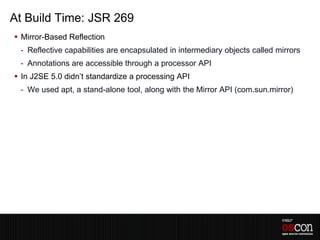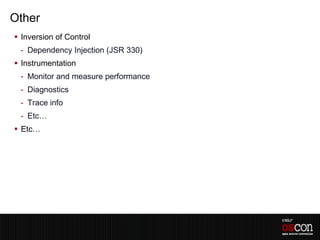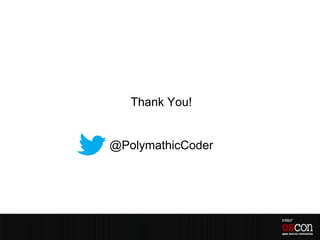The Art of Metaprogramming in Java
- 1. The Art of Metaprogramming in Java Abdelmonaim Remani @PolymathicCoder
- 2. About Me Software Architect at Just.me Inc. Interested in technology evangelism and enterprise software development and architecture Frequent speaker (JavaOne, JAX, OSCON, OREDEV, etc…) Open-source advocate President and founder of a number of user groups - NorCal Java User Group - The Silicon Valley Spring User Group - The Silicon Valley Dart Meetup Bio: http://about.me/PolymathicCoder Twitter: @PolymathicCoder Email: [email protected]
- 3. About Me Today is my birthday! 01001000 01100001 01110000 01110000 01111001 00100000 01000010 01101001 01110010 01110100 01101000 01100100 01100001 01111001
- 4. License Creative Commons Attribution Non-Commercial 3.0 Unported - http://creativecommons.org/licenses/by-nc/3.0 Disclaimer: The graphics, logos, and trademarks used this presentation belong to their rightful owners.
- 5. Metadata
- 6. What Is Metadata? The term “Metadata” was coined by Philip Bagley in 1986 in “Extension of Programming Language Concepts” Data about data or data that describes other data - Structural (Before there is any data) - Its type - Its valid values - How it relates to other data - Its purpose - Etc… - Descriptive (After data is there) - How it was created - The context within which it exists - Etc…
- 7. How Is Metadata Expressed? Implicit - Adhering to a certain convention Explicit - External to the code - DSL (Domain-Specific Language) - Markup: XML, RDF, etc… - Etc… - Internal to the code - As comments on code - Javadoc: @author, @version, @since, etc… - XDoclet - Etc… - As code itself - HTML meta tags: <meta name=“author” content=“Abdelmonaim Remani”> - Java Annotations: @Override, @Deprecated, etc… - Embedded DSL - Etc…
- 8. How Is Metadata Being Used? Schema - Data Dictionary in RDBMS - Check Constraints (JSR 303 Validation, Etc…) - Etc… Semantics - WSDL (Web Services Description Language) - RDF (Resource Description Framework) - Etc… Data Management - Build/deployment instructions (.svn files, .git, etc…) - Etc… Configurations Etc…
- 9. Metadata in Java: Annotations
- 10. Java Annotations JSR 175 (A Metadata Facility for the Java Programming Language) - Introduced in J2SE 5.0 (September 30, 2004) - Standardized how annotations are declared in Java code An alternative way to Javadoc comments, externally as XML, etc… - More readable - Closer to the code - Statically-typed - Can be retained until runtime
- 11. JDK Annotations Java Language Spec Annotations - @Override - @Deprecated - @SuppressWarning JSR 250 (Common Annotations for the Java Platform) - @PostConstruct - @Resource - @DenyAll - Etc…
- 12. Write Your Own You need to tell the compiler how the annotation is to be treated In java.lang.annotation package - @Target - The element type the annotation can be applied to - ElememtType.ANNOTATION_TYPE - ElememtType.CONSTRUCTOR - ElememtType.FIELD - ElememtType.LOCAL_VARIABLE - ElememtType.METHOD - ElememtType.PACKAGE - ElememtType.PARAMETER - ElememtType.TYPE
- 13. Write Your Own In java.lang.annotation package - @Retention - RetentionPolicy.SOURCE - Discarded by the compiler - RetentionPolicy.CLASS - Included in the class file but ignored the JVM. This is the default - RetentionPolicy.RUNTINE - Included in the class file and read by the JVM. - @Documented - Whether it should be shown in the javadoc or not - @Inherited - Allowed to be inherited by subclasses
- 14. Write Your Own Attributes - Carry additional metadata details - May only be - Primitives - Enums - Java.lang.String - Java.lang.Class - One-dimensional arrays of the above - May have a default value - No modifiers or parameters
- 15. Code
- 16. Notes Annotating a package - Must create a file named package-info.java in the target package - Note that “package-info” is not a valid Java identifier - Most IDEs you will prevent you from creating a class name “package-info” - Make sure you create it as a regular file with .java extension instead
- 17. Metaprogramming
- 18. What is Metaprogramming? Writing programs that write or manipulate other programs or themselves based on some metadata Metaprogramming -!= Generative/Automatic Programming Ralph Johnson - “It is about programming at the meta level, that is about changing your interpreter or changing how code is compiled” Black art and a Big-boy’s toy An underused feature Supported in many languages and across several platforms The backbone of many of the most successful frameworks
- 19. How is Metaprogramming Supported? Exposing the internals of the runtime/compiler as an API Dynamic execution of expressions containing programming commands - Code as Strings - Code as a series if method calls A program transformation system - A description gets transformed it to a target language - The compiler itself - YACC takes in grammar, and produces C/C++ code containing yyparse() - ANTLR (ANother Tool for Language Recognition)
- 20. Concepts Metalanguage - The language in which the metaprogram is written in Object Language - The language in which the target (produced) program is written in Reflection or Reflexivity - When metalanguage == object language - No translation necessary
- 21. Usage in code Static data that can be pre-computed or pre-generated at compile time Eliminate boiler-plate - Code that cannot be abstracted in functions for DRYness sake - Think Aspects in AOP - Stereotypes in Spring - Etc… - Code of common methods - Getters/setters, toString(), hashCode(), equals(), etc… Etc…
- 22. Benefits In code - Performance gain - Flexibility - Simplicity - Etc… Development - Minimize the LOC to express a solution - Productivity gain - Reduced development time/efficiency - Etc…
- 23. How to? Many techniques focused on specific aspects of metaprogramming No well-defined best practices This presentation is an attempt to bring in some structure through defining a process - Defining the metadata - Processing the metadata - Metamodel construction - Validating the metamodel - Metamodel interpretation
- 25. Metadata Processing Programmatically reading/accessing metadata - Parsing raw metadata - Call to an API - Reflection - Query - Etc… - Tools
- 26. Metadata Processing in Java: Annotation Processing
- 27. At Runtime: JSR 175 JSR 175: A Metadata Facility for the Java Programming Language - Defined the core reflection API for reading/accessing annotations on annotated elements at runtime as long as their retention policy extends to the runtime - Reflection - Reading annotations is done in reference to the structure of the program Libraries - Reflections: http://code.google.com/p/reflections/ - FEST-Reflect: http://fest.easytesting.org/ - ReflectASM: http://code.google.com/p/reflectasm/ - Etc…
- 28. At Runtime: JSR 175
- 29. At Build Time: JSR 269 Mirror-Based Reflection - Reflective capabilities are encapsulated in intermediary objects called mirrors - Annotations are accessible through a processor API In J2SE 5.0 didn’t standardize a processing API - We used apt, a stand-alone tool, along with the Mirror API (com.sun.mirror)
- 30. At Build Time: JSR 269 In Java SE 6 (December 11, 2006) - JSR 269: Pluggable Annotation Processing API -http://docs.oracle.com/javase/6/docs/technotes/guides/javac/index.htm - Leverages JSR 199 (Java Compiler API) - Javax.tools - Programmatically invoke javac - Implements ServiceLoader interface of SPI (JSR 24 - ServiceProvider API)) - Provides the DiagnosticListener interface to allow listening for warnings and error by the compiler - Extends javac as a plug-in allowing to write custom annotation processors - Seamless integration with javac - Finds if there is an annotation registered to process a particular annotation - Plugs it into the compiler
- 31. At Build Time: JSR 269 JSR 269 Defines 2 APIs - Writing annotation processors and interacting with the processing environment - Javax.annotation.processing - Modeling the Java Programming Language - Javax.lang.model - Type declarations and types (Accommodates Generics)
- 32. Code
- 33. Code Implement javax.annotation.processing.Processor or extend javax.annotation.processing.AbstractProcessor - Process method - Returns whether or not the annotations processed are claimed by the processor. This determines whether other processors can further process them or not Configure the processor using annotations - @SupportedAnnotationTypes - Register the annotations to be processed with their full-qualified name. Wildcats are supported as well - @SupportedSourceVersion - The Java version supported - @SupportedOptions - Register supported command-line options
- 34. Code Annotation processor registration - Javac command-line options - -processor <processor classes> - -proc:none or -proc:only. It is enabled by default - -processorpath <annotation path> - Leverage JSR 24 (ServiceProvider API) to automatically register processors - Compile the processor with –proc:none and package it in a jar - Include in META-INF/services a file named javax.annotation.processing.Processor containing a text entry of the full- qualified name of the processor class - Optional: Multiple processor can be registered or ordered
- 35. Metadata Processing Annotated elements might have nested annotated elements and so forth Visitor Design Pattern - Separation of annotation processing code from the object structure
- 37. What is a Metamodel? Metadata is processed into a model that can be accessed programmatically - Static - Dynamic A association of the data and its metadata
- 38. Static Metamodel - A metamodel based on - One all-knowing “god object” encapsulating all possible metadata values that could be associated with the one annotated element - Advantages - Simple - Statically typed - Disadvantages - Nulls all over
- 39. Static Metamodel
- 40. Dynamic Metamodel Ravioli Code - Metamodel is structured in small and loosely-coupled components Decorator Design Pattern - Annotated elements are decorated with annotations that bring in metadata Advantages - Flexible Disadvantages - Complex
- 43. Validation? Ensuring the validity or correctness of semantics of the metamodel - Verification that a set of constraints are satisfied Compliance additional consistency constraints outside the Java language specification - Java only has @Target Example - Assuming that you are writing your own JSR 318 (Enterprise javabeans 3.1) implementation - You should not allow a POJO to be annotated with both @Statefull and @Stateless
- 44. Constraint Satisfaction This is anything but simple - A Constraint Satisfaction Problem - Can be resolved by multiple algorithms (Backtracking, Constrain reparation, and local search) - These algorithms are out of the scope of this presentation
- 45. Validating the Metamodel The imperative way - In Java - A jungle of conditional statements
- 46. Validating the Metamodel The logical way (Logic Programming) - Semantics are represented declaratively as predicates (Facts and Rules) - Procedurally interpreted query resolution - Constraint Logic Programming (An extension of Logic Programming) - Used for digital circuit verification • Prolog is King - tuProlog: Implementation of the Prolog interpreter in Java - http://alice.unibo.it/xwiki/bin/view/Tuprolog/ - Jlog: Implementation of the Prolog interpreter in Java - http://jlogic.sourceforge.net/ - JPL: Java Interface to SWI Prolog - http://www.swi-prolog.org/FAQ/Java.html Yeah you’re gonna have to learn that
- 47. Validating the Metamodel Clojure - Lisp-like language on the JVM - core.logic supports logic and constraint programming Other - Prova Rule Language - http://www.prova.ws/ - Mercury - http://www.mercury.csse.unimelb.edu.au/
- 48. Validating the Metamodel Rules Engine - Drools Expert - A highly performance optimized rules engine - Rules are written in mvel (A powerful expression language) or XML - Integrates with Java collaborator POJOs
- 50. Transformations Changing the structure of existing code - AST (Abstract Syntax Tree) rewriting - Adding/removing behavior - Automatic generation of cookie-cutter code - Create complex class hierarchies Notable byte code manipulation libraries - ASM - GCLIB - Javassist - Etc…
- 51. Transformations ASM - Small - Fast - Low-level - Require a good understanding of byte-code and Java Language Spec - Good documentation - http://asm.ow2.org/ GCLIB - Built on top of ASM - High performance - Issues with signed jars - Dropped by Hibernate in favor of Javassist for lack of support and active - http://cglib.sourceforge.net/
- 52. Transformations Javassist - Very easy to use - Works with signed jars - Good documentation - Excellent Javadoc - Adopted by hibernate - Slower than GCLIB - http://www.jboss.org/javassist/
- 53. Weaving in Cross-Cutting Concerns OOP creates a hierarchical object model by nature Certain things are not necessary a part of the application logic - Logging - Transactions - Security - Etc… AOP (Aspect Oriented Programming) - Code weaving - Dynamic Proxies
- 54. Mapping Map one object to another based on the metamodel Example - Dozer - http://dozer.sourceforge.net/ - ORM Frameworks
- 55. Mapping Metadata Row Class Metamodel POJO Class Mapper Creates Row Instance POJO Instance
- 56. Other Inversion of Control - Dependency Injection (JSR 330) Instrumentation - Monitor and measure performance - Diagnostics - Trace info - Etc… Etc…
- 57. Metaprogramming in the Wild
- 58. Metaprogramming in the Wild Spring - Lightweight POJO-based frameworks - Non-invasiveness - Stereotyping a class in lieu of inheritance to acquire behavior - Arbitrary methods signature instead of overriding inherited ones - Declarative configuration - Dependency Injection Rails - Rapid Development - Convention over configuration - Active Record Pattern Hibernate/JPA (JSR 317) - ORM Guice Spring AOP Etc…
- 59. Model-Driven Engineering Philosophy - In an application - Artifacts that are good candidates for auto-generation - Why? - The architecture is defined by - Making abstractions guided by the separation of concerns - Most deal with the same concerns - Avoid rediscovering the best approach every time - Code generation, Scaffolding, etc…
- 60. Project Averroes
- 61. Averroes A metaprogramming framework - Auto-discovery of annotations - @Discoverable - Annotation processing - Metamodel construction - Metamodel validation - Annotations of annotations (meta-metadata) - @AccompaniedWith - @AccompaniedWithAtLeastOne - @ForType - @ForTypeAnnotatedWith - @ForTypeIncluding - @NotAccompaniedWith A work in progress… - https://github.com/PolymathicCoder/Averroes
- 62. Questions?































































